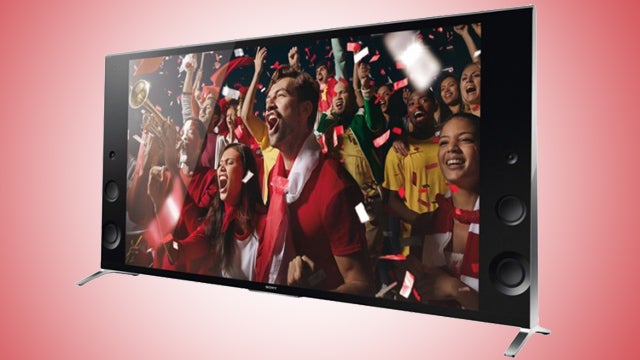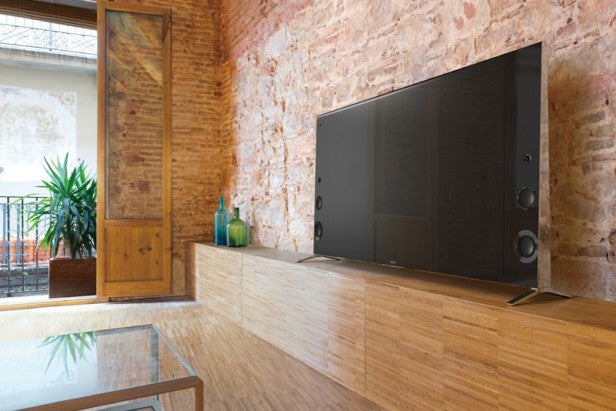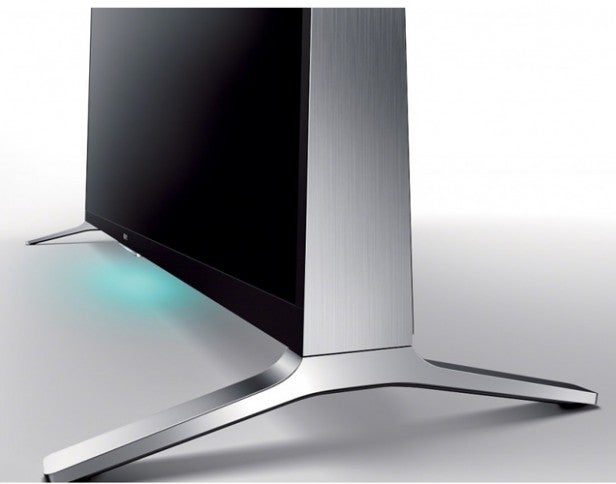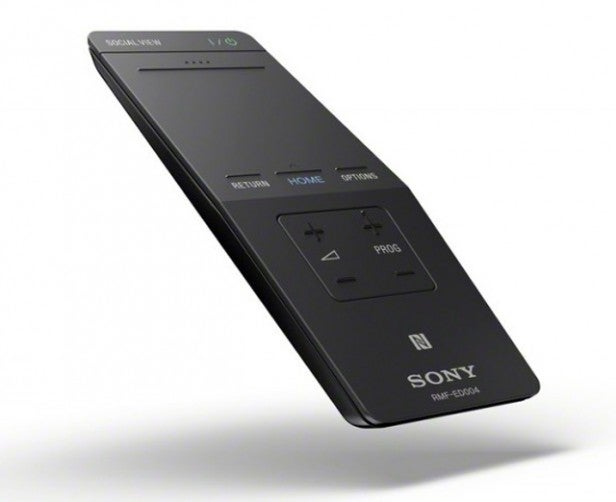Sony KD-65X9005B Review
Sony KD-65X9005B
Editor's Choice: Sony sets a new standard for 4K TVs

Sections
- Page 1 Sony KD-65X9005B Review
- Page 2 Picture Quality Review
- Page 3 3D, Sound and Verdict Review
Verdict
Pros
- Spectacular 2D picture quality
- Best audio ever heard from a flat TV
- Great value by 4K standards
- Supports 4K Netflix streams
- HDMI 2.0 supported
Cons
- 3D not as good as 2D
- No 4OD or ITV Player
- Dynamic Contrast engine can go too far with some presets
Key Specifications
- Review Price: £3600.00
- 65-inch LCD TV with edge LED lighting
- Native 4K/UHD resolution
- Active 3D playback (2 pairs of glasses included)
- 4K X-Reality Pro processing
- SEN smart TV platform
What is the Sony KD-65X9005B?
The 65-inch 65X9005B is one of our most eagerly anticipated TVs of the year. Why? Because it kicks off Sony’s second generation of 4K/UHD, building on last year’s sensational 65X9005A with a plethora of new improvements and features while also delivering a massive price drop. In other words, if it performs as we’re hoping it will, it could become 4K’s new poster boy.
SEE ALSO: Best 4K TVs

Sony KD-65X9005B: Design and Features
The 65X9005B wants to have its cake and eat it in design terms. By which we mean that it wants to look eye-catching and original without compromising performance – specifically, as we’ll see, audio performance.
The most immediate result of this policy is that the 65X9005B is big. Really big. The usual obsession with super-skinny screen frames is squished under the size 12 boot of a bezel that stretches for miles beyond the already considerable screen acreage in order to make room for six front-firing speakers (three to either side).
The space afforded to these speakers is even bigger than that given over to the brilliant speakers built into last year’s 65X9005A – and it isn’t restricted to the TV’s width, either. Sony has also given its speakers more depth to work with courtesy of ‘the wedge’. This sees the TV getting deeper around the rear as your eye travels down from top to bottom, resulting in a vaguely pyramid-like shape when viewed from the side that’s emphasized by a reflective metal side panel.
Add this rear to the huge black wings to either side of the screen and as we said earlier, the Sony 65X9005B represents a huge chunk of AV real estate for your living room to accommodate. But here’s the crucial point: personally we think the 65X9005B looks lovely.
The way the speakers are cut into a gorgeous glass front plate, the way the plate wraps around the curved top edge, the cute circular accents around the speakers and the bold contrasts between the silver feet and side panels and the deep black of everything else all add up to a look worthy of dominating any room.
The Sony 65X9005B even tries to tidy its rear up by shipping with a port replicator: an external box that mirrors all the inputs found on the TV so that you can funnel your sources to the TV through a single cable that ultimately opens out into cluster of labelled output cables over its last three-four inches for insertion into the TV’s sockets. Then there’s a plastic cover that sits neatly over the connections ‘bay’, allowing you to hide away the usual cable spaghetti.
The cable from the replicator to the TV isn’t as long as we’d have liked it to be to provide the best placement flexibility, and Sony’s cable-tidy solution is not, it must be said, as elegant as Samsung’s external connector box option, which streams all of the TV’s inputs into the TV using just a single proprietary cable. It’s important to stress, too, that Sony’s Port Replicator box doesn’t contain the TV’s microchip ‘brains’ like Samsung’s external connection box does. This means won’t be able to use a future port replicator version to upgrade the TV’s operating system like you can with Samsung’s connection box.
Despite these caveats, however, anything that tidies the cable carnage of modern life up even a bit has to be a step in the right direction, at least.
You may also like:

Picture Technology
Shifting our focus from outside to inside the Sony 65X9005B, its main feature is, of course, its native 4K (aka UHD) resolution. Regular readers will know that we’ve fallen hook line and sinker for the charms of squeezing 3,840 x 2,160 pixels into a TV screen, and with Sony doing such a great job of optimizing the new higher-res picture format last year, we seriously excited about what the brand might be able to deliver this year. Especially given that Sony claims to have introduced some key new picture improvement technologies.
Perhaps the most intriguing of these new technologies is Sony’s X-Tended Dynamic Range system. This combines improved local manipulation of the edge LED lighting array (aka local dimming) with enhanced signal control via the TV’s processors to boost the brightness of light parts of pictures while simultaneously improving the black level response of dark areas. The result is hopefully a much more contrast-rich image with enhanced shadow detail reproduction.
Sony has also interestingly tweaked the Triluminos colour technology that was such a hit – in most ways – on its high-end 2013 TVs. It no longer uses the so-called quantum dot technology to deliver an expanded colour range, with the extra colour resolution now coming from an improved panel design.
Sony is being atypically cryptic about the specifics of how this colour-enriched panel works, but as we’ll see presently, the new Triluminos still delivers the goods. Sony has also added a new, second ‘Cinema’ preset to its picture options designed to deliver an authentic movie-like experience but with an enhanced contrast performance. This might sound like a small move on paper, but actually it’s part of a bold shift to openly challenging the idea espoused by some parts of the AV world that achieving the best picture quality from a TV is merely a matter of reproducing as closely as possible the now ageing Rec 709 picture standard.
The argument Sony puts to support this point of view is brilliantly simple. The main point is that while it agrees a TV should ‘realise a director’s intention’, the simple truth is that home AV systems cannot – due to myriad legacy technical, signal format and display limitations – actually reproduce a director’s intention. All it can do is produce a watered down version of that intention delivered to an established standard.
So if a TV really wants to try and reproduce what a director actually shot at the point of content creation it needs to restore the information – gamma, resolution, colour gamut, motion clarity, dynamic range etc – lost in the course of downgrading it to a uniform standard for home distribution. We’ve been making a similar point for some time now, so it’s great to see a major brand having the guts to come out and say it in the face of an industry that’s become entrenched in what’s increasingly feeling like a limited, reductionist way of seeing things.
Even better, Sony is also now openly agreeing with another of our TV beliefs: that the obsession with reproducing pictures to a standard totally ignores the simple fact that different people have different tastes. This is where the Cinema 2 mode comes in. While the TV’s Cinema 1 setting aims for ‘accurate’ picture reproduction, the Cinema 2 one aims for a much more dynamic, punchy, clean and polished image that experience suggests most end users will actually prefer to watch.
If you’re worried all this increased picture flexibility is going to make the 65X9005B horribly complicated to use, by the way, don’t be. We’ll talk more about why in the set up section.
4K Content Support
The driving force behind the Sony 65X9005B’s picture technologies is the latest version of Sony’s 4K X-Reality Pro processing system. This uses a huge database of picture knowledge to recognize different types of incoming source and apply a set of pre-defined processing rules to them, delivering a processing short cut that should help deliver more effective results ‘on the fly’. This system proved hugely successful on last year’s models, especially when it came to upscaling HD and even standard definition sources to the screen’s 4K native resolution. This was a particularly welcome talent, of course, given that last year there were precisely zero native 4K video sources for the TV to feed on.

The lack of native 4K sources remains an issue now. However, there is one… and the Sony 65X9005B can play it. That source is Netflix, which launched a native 4K streaming portal back in April. And thanks to its built-in HEVC decoding the Sony 65X9005B can handle these ‘Ultra HD’ Netflix streams perfectly – so long as you happen to have a 15Mbps or faster broadband connection…
Inevitably there aren’t exactly many of these UHD streams right now; just a few nature documentaries and, excitingly, Netflix’s home-grown House of Cards series. But obviously more 4K content – and service providers – will slowly but surely emerge over time, and it’s great to know that the Sony 65X9005B will be able to handle them when they do.
The Netflix support is just one part of a much wider online content service available through the TV’s Sony Entertainment Network. We’re not going into this in more detail here, though, as we’ve got lots of other stuff to get through and we’ve already gone in-depth in our Sony Smart TV 2014 review.
Connections
There are three more features to briefly cover before really getting our teeth into the 65X9005B. First, connectivity is strong, with highlights of four HDMIs (this year crucially built to the 4K-friendly v2.0 standard to deliver 60fps 4K with less colour resolution compromise), three USBs and both LAN and integrated Wi-Fi network options.
The set also supports 3D playback using the active format, with two pairs of glasses included. Previous Sony 4K TVs have used passive technology, so it will be interesting to see how the 65X9005B does at upscaling 3D Blu-rays to 4K, as it needs to in an active 3D scenario.
Finally, we should spare a further thought for the Sony 65X9005B’s striking speakers. For as well as hopefully benefitting from the extra space provided by the wedge design, Sony has also partnered its magnetic fluid speaker technology (which allows more power to be reproduced from slim speaker designs) with a shift to a new diaphragm design that combines a glass fibre construction with Mica particles to boost power, clarity and response speed.
Sony KDL-65X9005B: Set Up
After a straightforward initial set up routine, day-to-day use of the Sony 65X9005B is something of a mixed bag. The One Flick remote you get with the TV provides a worthwhile touchpad-equipped, button-reduced alternative to the ‘normal’ remote, once you’ve got used to its actually quite clever contextualized approach. Though actually, we think it could have benefited from having a couple more buttons added without its minimalism being excessively compromised.
The onscreen menus are OK, though we question the decision to only allow access to the TV’s main picture and sound set up menus via a tiny icon in the top right corner of the main smart hub screen. This main smart hub also looks bizarrely empty when you first get it, requiring you to spend a few moments setting up some favourite apps in the large window provided for that purpose before the hub starts to become useful.

The new Sony Discovery interface, though, does a good job of streamlining the process of finding interesting content, and even better the X-Reality Pro’s cleverness at knowing what to do with different source types makes the Sony 65X9005B exceptionally clever at automatically picking the best picture presets (from a superbly wide selection), with minimal input required from the viewer.
Given how few people bother tinkering with their picture presets when they get a new TV home, the Sony 65X9005B’s auto-optimisation cleverness is worth its weight in gold.
If you do want to mess about with picture settings, however, there are certainly plenty of tools to get your teeth into. Among the most useful are multiple settings for Sony’s excellent MotionFlow processing for tackling judder and motion blur, multiple settings for the Reality Creation system connected with Sony’s 4K upscaling (including noise filtering and resolution adjustments), and multiple settings for the various features associated with enhancing contrast: a black correction system, an ‘advanced’ contrast enhancer, and the LED Dynamic Control system that drives the screen’s local dimming circuitry.
A couple of recommendations we’d make are that you only use the Advance Contrast and LED Dynamic Control Systems on their Low levels, for reasons we’ll discuss in the performance section.
Also, slightly ironically given the comments we made about the Cinema 2 mode earlier, we feel you might prefer to use the Cinema 1 preset for watching at least those films that have a lot of dark content. Again, we’ll cover our reasons for saying this in the next section.
How we test televisions
We test every TV we review thoroughly over an extended period of time. We use industry standard tests to compare features properly. We’ll always tell you what we find. We never, ever, accept money to review a product.

